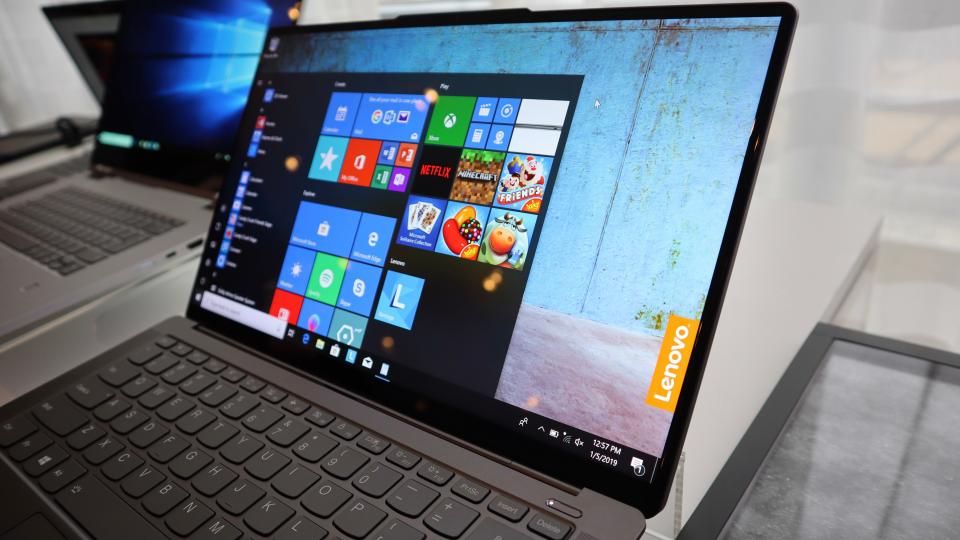
This 13.9in laptop has standout design and an eye-catching edge-to-edge screen
Save £300 with the eCoupon SNEAKPEEK
The tenth-gen Intel Core i5 model of this laptop is currently discounted by £300. The model on offer comes with 8GB RAM and 512GB storage, along with integrated Intel Iris Plus Graphics.LenovoWas £1,399Now £1,099Buy Now
Lenovo always likes to make a splash at CES, the world’s largest consumer technology show, and this year is no different: the company has announced a total of 20 products. These include a smart clock and the A940 all-in-one desktop PC with a screen that folds down, but it’s the Yoga S940 that caught our eye.
Why? Much stems from the iron grey aluminium chassis, while a curved-edge screen that echoes premium phones such as the Samsung Galaxy S9. But it’s also slim, light and powerful, with a webcam that packs some fancy “AI” features.
Lenovo Yoga S940 review: Key specifications, price and release date
- Display: 13.9in, up to 3,840 x 2,160 with Contour Glass
- Processor: 8th-Gen Intel Core i7
- Graphics: Intel UHD Graphics 620
- Storage: Up to 1TB PCIe SSD
- RAM: Up to 16GB LPDDR3
- Connectivity: 2 x Thunderbolt 3 USB-C, 1 x USB-C 3.1 Gen 1
- Dimensions: 12.2 x 319 x 197mm (HWD)
- Weight: 1.2kg
- Audio: Front-facing Dolby Atmos Speaker system
- OS: Windows 10 Home
- UK price: TBC (Starts from $1,499 in US)
- UK release: May 2019
Lenovo Yoga S940 review: Design and features
Let’s tackle the design first. Not everyone will fall in love with the iron grey finish, but it has an industrial look that distinguishes it from the lighter grey of a MacBook or Microsoft Surface. And, thanks to the aluminium, you’ll simply delight in the fact you’re getting such a large screen in a machine that weighs 1.2kg.
At 12.2mm thick, and measuring a compact 319mm wide, the Yoga S940 will slip neatly into any rucksack. How long it lasts on your day trips will depend on which screen you choose. The model we saw used an Ultra HD 4K panel with a maximum 500 nits brightness. Images jump from the screen and, with support for the HDR400 playback standard, you can be sure HDR footage plays back as it should, with a vibrancy that could easily pass for an OLED panel.
The downside is that Lenovo claims 9.5 hours of battery life compared to the up to 15 hours of life if you choose the Full HD (1,920 x 1,080) panel. While we do love the ultra-bright 4K screen, it probably makes sense to stick to the Full HD version.
Whichever you choose, you’ll benefit from Lenovo’s “Contour Glass”. As you might imagine, this curves at the edge to give an “infinity edge” appearance – helped by 4.2mm-wide bezels at the left- and right-hand side.
Even the top of the screen is interesting. Lenovo adds an extra bit of space so it can squeeze in an infrared camera and a webcam, with the promise that “AI sensors” can detect if you’ve walked away from the laptop and lock your display automatically.
It even promises that it can track where your eyes are looking, and move open windows to a connected external screen. Intriguing, but we couldn’t put this theory to the test.
One word of caution to keen typists: the keyboard isn’t up the high standards we see from Lenovo’s ThinkPad brand. It had an insubstantial feel, while the half-height Enter key will take some getting used to.
Lenovo Yoga S940 review: Early verdict
With a US price of $1,499 – we haven’t yet received confirmation of the UK price, but it’s likely to be around £1,399 – this is a premium laptop. And it certainly looks like one too, with excellent build quality to back it up. Note that this price is for a Core i7 specification, too, so it’s likely to fly through tasks.
What stops it from winning a Best of CES award is that underwhelming keyboard and the sheer level of competition in this realm. Just consider the Huawei MateBook X Pro, which also includes a 13.9in screen, looks fabulous and costs from £1,000. (Admittedly, the MateBook’s pop-up webcam is truly awful.)
Still, we look forward to seeing the final version when it comes out in May 2019. It adds yet another option for anyone searching for a stylish, light, powerful laptop.
